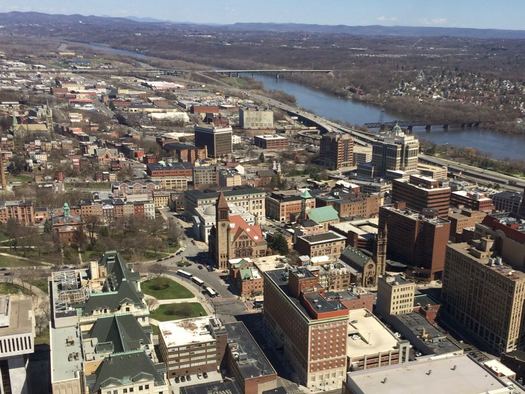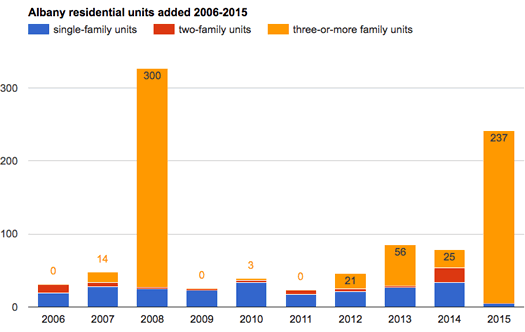A few more bits about Albany's inclusionary zoning proposal

Update: The Common Council approved the Rezone Albany package 12-3. More to come.
____
Rezone Albany -- the big overhaul of Albany's zoning rules that's been more than two years in the making -- is in line to be approved by the Common Council Monday evening.*
The project has touched on a bunch of topics that routinely get people talking, such as: What sorts of businesses can open where? How late can they be open? How can old buildings be adapted for new uses? How can neighborhoods suffering from disinvestment gain new life?
And near the end of the process the issue of affordable housing became a hot topic of discussion as it related to Rezone Albany -- specifically a requirement added as an amendment at the last moment that will require developers to set aside a certain number of affordable units in some projects.
As people have tumbled this topic -- known as inclusionary zoning -- they've had a lot of questions about this will work. We've seen them in comments here on AOA, on social media, and we've had people ask us in person.
So here are some answers. (And, well, also some more questions.)
Recap
Here's an earlier look at some of the arguments for and against inclusionary zoning.
How the actual provision reads
Rezone Albany is a huge package of rules and guidelines that stretch across more than 300 pdf pages. But the inclusionary zoning provision is quite short:
(b) AFFORDABLE HOUSING REQUIREMENTS
After December 1, 2017, each new residential or mixed-use development or redevelopment containing 50 or more new dwelling units shall sell or rent at least five percent of its new dwelling units at sales or prices affordable to persons earning no more than 100 percent of the area median household income for the City of Albany, as determined by affordability methods used by the U.S. Department of Housing and Urban Development.
That the whole provision. And because the rule is relatively short on specifics, the city of Albany has a bunch of questions it needs to work out between now and December for the requirement. Here are some of them...
What will be the income limit for these affordable units?
As mentioned in Rezone Albany package, the income limit for the affordable units will be set relative to the median household income of the city, as figured according to HUD methods. HUD publishes these numbers online for counties and metros, and it helpfully walks through its own math, based on Census data, so we can do the same calculation for the city of Albany.
Using the HUD method, the median household income for the city of Albany for fiscal year 2017 is $45,700.
The guideline for housing affordability is typically 30 percent of income. Anything above that a household is considered cost burdened.
So 30 percent of the city's median household income is: $1,143. That's not necessarily the exact number the limit will end up being, but it will probably be close to that.
For some perspective, a housing market report prepared for the city by a consultancy last year reported that the estimated median rent in Albany n 2014 was $896. (Adjusted for inflation to 2017 that's about $925.)
The initial inclusionary zoning proposal floated for Albany had the income limit at 80 percent of the median income, at which the 30 percent-of-income rent would be $914. So shifting the limit to 100 percent shifted the rent limit a significant amount.
Chris Spencer, Albany's planning director, said last week that how the city calculates affordability will be something to consider as it monitors the inclusionary zoning provision. "Is 30 percent the right number? Is it different if you have access to transportation or can walk to work? Is it different based on type of family?"
If a person's income rises past the limit, will they be able to stay in an apartment?
Spencer said that's not clear yet, but as the provision is written it could be interpreted to mean that a person would have to give up an apartment if their income rises above the limit. But he said in some cities the system works more like something along the lines of income-based rent control.
"I'm not sure how this will work," he said. "We'll look at federal guidelines and what other cities have done."
Will the affordable units be like the other units in a building?
It's another issue that's not settled right now, but as Chris Spencer pointed out: "Certainly the way it's written right now doesn't require them to be identical or indistinguishable."
He said some cities do require that mandated affordable units are just like the other units in a building, others mandate the units appear from the outside to be the same or to be mixed through a development, and others don't have rules for that.
How will the affordable units be made available?
Spencer said developers will be able make to units available to renters as they see fit -- whether it's first-come-first rent or via a lottery or some other other method -- as long as they're following the income rules.
How will these requirements be tracked?
Spencer said the details still need to be worked out, but he said city staff is sensitive to potential administrative burden for developers and the city itself. "We want to standardize it and make it as easy as possible."
He said it's possible the reporting of tenants' income could just be a matter of a building owner collecting copies of tax documents listing income from tenants.
How many projects could be affected?
Spencer said that's hard to say. But he figures there are 2-3 projects in the pipeline right now that would be subject to the inclusionary zoning requirement if it was already in place.

The number of residential units added in the city of Albany over a 10-year span. The number of units in buildings with three-or-more units are noted for each year. (That big blip in 2008 is The Alexander on Washington Ave.)
Looking back at the last decade of development in the city, there have been very few projects that cross the 50-unit threshold and would have been subject to the requirement. But the last two years have seen an upswing in this sort of larger residential development.
A few examples:
+ The Park South mixed-use redevelopment that will eventually have 268 new units.
+ The planned Nipper building conversion with as many as 75 units.
+ The 760 Broadway project with 100 units, which got site plan approval last fall.
+ The mixed-use project proposed near Quackenbush Square with 180 units that made its first appearance before the planning board this past January.
What effect will this have? How will the city know?
In the lead up to adding the inclusionary zoning provision, the consultants that have been working with the city on Rezone warned the measure could imperil the city's recent development momentum the city's housing market was not especially strong. And when Common Council members requested the addition of the measure, Spencer told them the city would have to carefully watch how it affected development and adjust if necessary.
But getting a sense of whether inclusionary zoning ends up adding new, affordable housing without acting as a brake on development could be difficult because the city doesn't much of a baseline from which to work. If the city was routinely seeing the addition of, say, 500 units a year in large buildings, it could watch for dips in that number in later years. It just doesn't have that pattern to work from.
"In the Warehouse District, when your baseline is zero, if you build 10 apartments you could say the program's working," Spencer said, referencing an area where there has previously been little or no housing development because of the existing zoning rules, "But is it? And that's the thing -- would you be building more without it?"
Spencer said the city is facing a situation in which the costs of developing new housing there are more expensive than other places. Yep, taxes are a part of that. But so are costs associated with building on contaminated sites, or having to perform archaeological surveys, or rehabbing old structures. Unlike its suburban counterparts, the city doesn't have many available "greenfield" sites where everything is more or less set to go.
"I think someone who's planning on doing a hundred unit building is probably not going to scale back," Spencer said. "But someone who's doing 60 might say, you know what, 40 makes more sense. These things always run the risk of having the opposite intended effect."
____
* For the second time -- after postponement of the vote two weeks ago because of a potential issue regarding the posting of proper notice for a council committee meeting.
Say Something!
We'd really like you to take part in the conversation here at All Over Albany. But we do have a few rules here. Don't worry, they're easy. The first: be kind. The second: treat everyone else with the same respect you'd like to see in return. Cool? Great, post away. Comments are moderated so it might take a little while for your comment to show up. Thanks for being patient.
Comments
I attended the meeting in which this subject was discussed at great length by the City's Re-Zone consultant. He was quite adamant that inclusion of this type of provision is pretty much meaningless; he elaborated at great length about how nothing near these goals have been met in other cities where they have been included.
He did make it quite clear that the best way to facilitate affordable housing is one building at a time, through re-hab efforts of individuals and small companies., which is none of the members in the committee meeting I attended seemed to be interested in. He also talked at great length about loss of large numbers of affordable units that disappear every year in the city. Only one member of the Council evinced any interest in finding out the how and the why and what could be done.
I watched members of the CC be told by the expert they were paying big bucks that enacting such a provision was simply a feel good proposition, which no real meaning . Optics is really all most members of this Common Council care about. Especially in an election year.
Per the consultant.. it's really hard work for city to develop more affordable housing units. The CC members apparently aren't willing to do the heavy lifting and prefer the magical thinking provision.
... said j on May 15, 2017 at 7:23 PM | link